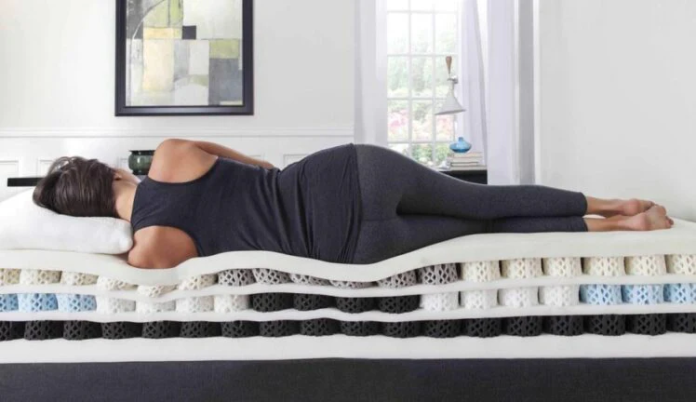Changing your mattress may not always be the best option for sciatica. The right mattress may help reduce pain and improve spinal alignment. A medium-firm mattress may be best for you. A firmer mattress will also support heavier people. It would be best if you also considered the density of the foam.
Can a mattress cause sciatica?
Sciatica is a painful condition caused by issues with the spinal discs and pressure on the sciatic nerve. The symptoms can be aggravated by sleeping on an uncomfortable mattress. The ideal sleeping position is on your back, as this will relieve pressure on the nerve. A supportive mattress will cushion your back and eliminate the discomfort associated with sciatica.
A mattress with adjustable features can prevent sciatica by helping you sleep on your side. It can also reduce pain by supporting your lower back and lowering your knees. The best mattress for sciatica sufferers is one with memory foam, which offers excellent support for the lower back.
A high-quality pillow is important for sciatica support. A firm quality pillow keeps your spine aligned and relieves the pressure on your lower back and leg. For extra support, you may consider a wedge pillow. You may also consider sleeping with your knees elevated. This will relieve pressure on the sensitive nerves and lumbar discs.
It would be best if you considered getting an orthopedic mattress. This mattress will relieve pressure on the spine and help you get a good shut-eye. You may need to change your mattress to an orthopedic one if your back or leg pain persists. You can also consult your doctor to determine which mattress is best for you.
Does Memory Foam Help Sciatica?
If you are a sciatica sufferer, you’re probably wondering if memory foam can help. Memory foam is a material that conforms to your body while you sleep, providing additional support and comfort. It also helps reduce motion transfer. This makes it a great choice for people who suffer from sciatica.
Memory foam helps reduce pain in several ways, including helping the body contour to the spine curve. Some mattresses have a gel-infused foam to reduce heat buildup and relieve pressure. These foams are great for relieving sciatica, so purchase a mattress with this technology.
Another way to ease sciatic pain is to get plenty of rest. Long periods of sitting can lead to compression of the sciatic nerve, causing pain down the leg. Patients should avoid sitting down for long periods to prevent this pain from developing. In addition, hard surfaces may not provide enough support, so it’s important to alternate sitting and standing up every once in a while.
Is A Hard Bed Better For Sciatica?
Many people with sciatica will need to change positions at night to find a comfortable position. This is especially important if you sleep on your side. A mattress that relieves pressure in the right area is crucial. Mattresses made of latex or memory foam are the best for this purpose. A mattress with strong edges is also important if you have trouble getting in and out of bed.
A mattress designed for sciatica must provide adequate cushioning around the sciatic nerve, which originates in the buttock and runs down the thigh and lower leg. This should eliminate pressure in the lower back and resist deep sinking. The best mattress for sciatica sufferers will vary in firmness and support based on weight and position. It is recommended to experiment with different positions for at least one week and several nights before settling on a new position.
If you suffer sciatica pain on one side, you might consider sleeping on your back. If you do this, you can also use strategically placed pillows to prevent rolling onto the painful side. Avoid sleeping on your stomach, as it can cause the hips to sink into the mattress. This can place pressure on the lower back and neck.
Is An Extra Firm Mattress Good For Sciatica?
Extra firm mattresses may help you sleep more comfortably at night when you suffer from sciatica. Stomach sleeping is not recommended for anyone suffering from back pain, let alone sciatica. These mattresses are designed to help you avoid pain and to keep your spine straight. However, they’re also tough on your body. People who suffer from sciatica often toss and turn all night in search of a comfortable position. They may also struggle with bladder control.
One way to find the best mattress for your needs is to research the different firmness options. You can also look for a memory foam mattress that can conform to your body and relieve pressure. Some mattresses offer sleep trials, so you can try them out for a night to see if they are right for you. If you don’t like them, you can return them for a full refund.
Choosing the right mattress is crucial, and you should try to avoid a bed that is too firm. The wrong bed can aggravate your sciatica. In addition, a poor mattress can cause poor posture while you sleep, contributing to your low back pain.
How Should I Sleep To Fix Sciatica?
If you have sciatica, one of the best things you can do is to change your sleeping position. While sleeping on your back can be very uncomfortable, sleeping on your side can help relieve pressure on the sciatic nerve and open up narrow spaces in your spine. Also, it would be best if you used a pillow that supports your tailbone and lower back.
A medium-firm mattress helps maintain proper spinal alignment, which can help prevent pain. You can also try sleeping on a mat or towel on the floor. This may be uncomfortable initially, but you may experience relief as you adjust. Using a pillow to support the other parts of your body is also important.
Another way to sleep to fix sciatica is to elevate your legs. A two-piece wedge-shaped cushion can help you achieve this position. You can also place two flat pillows under your knees and two plump pillows behind your shoulders. A wedge-shaped pillow allows you to sleep in a semi-rectangular position and relieves pressure on the lumbar spine nerve roots.
In addition to sleeping on your side, you should try sleeping on your stomach. This position helps distribute weight evenly across your spine and reduces pain in your back. If you have sciatica, you should avoid sleeping on your back.
What Are The Signs Of Sciatica Getting Better?
If you’re suffering from sciatica, changing your mattress can help ease the symptoms and help you sleep better. A new mattress will support your back and provide a comfortable resting place. You can start by stretching the affected area and moving around a little bit. If this doesn’t work, you can try an adjustable bed to help relieve your pain.
A slipped disc usually causes sciatica. The condition can get worse before getting better. Sometimes it gets better on its own, but in some cases, it needs medical treatment to correct the underlying issue. Often, it’s possible to get better without medication or physical therapy.
The best way to decide whether or not a new mattress is right for you depends on your specific condition. For example, your sciatica may be caused by a weakened lumbar spine or improper positioning. It could also be caused by an injury that causes the pain.
You might also want to try a warm bath or shower. These will help relax the muscles in the affected area and help you get to sleep.
What Should You Not Do With Sciatica?
Sciatica is a common ailment affecting the spine and your sleeping habits. It’s not always treatable but manageable, and you can learn to sleep with it. To make your sleeping experience more comfortable, you need to know what to look for in a mattress. The firmness level of your mattress is critical in managing your sciatica symptoms.
For pain relief, try sleeping on your side or back. These positions will help to distribute your weight evenly across your back. Avoid sleeping on your stomach, which can only worsen your sciatica symptoms. Also, soft mattresses can cause more pain. In addition, your body’s temperature will fluctuate throughout the night, making it difficult for your body to rest and recover.
Buying a mattress zoned for sciatica is critical for relieving pain and discomfort. If your sciatica symptoms are caused by sleeping on your side, a pillow placed strategically between your knees may provide relief. However, it’s best to consult your healthcare provider before starting any treatment.
Conclusion
Sciatica pain often originates in the lower back, so a mattress firmness that supports this area and eases pressure on it will be a welcome relief. Mattresses that have solid support and relieve pressure points help people with sciatica by relieving pain and allowing a better sleeping position. Types to look for include memory foam and hybrid mattresses. Memory foam mattresses contain different materials, such as memory foam, latex, and springs.
An innerspring memory foam mattress is an affordable, reliable choice for these people. For instance, those with sciatica will want a bed with optimal pressure relief and little motion transfer— with this in mind. An innerspring mattress would be a poor choice to achieve good sleep quality. As well as investing in a good, supportive mattress, there are some bedtime habits that you can develop that will relieve pain and increase the quality of sleep that you get.
They can also adjust the mattress firmness for each side of the bed. The first is its medium firmness, which rates a 6/10 on the mattress firmness scale. Look for the best memory foam mattress for sciatica. The best memory foam mattress will help ease the pain and improve sleep quality. The foam offers support for both back and stomach sleepers, though back and stomach sleeping are not ideal for people with sciatica, as these sleeping positions both increase pressure on the lower portions of the spine.

Doctor Osvaldo Pepa, Neurosurgery Service Physician at Hospital San Martin, La Plata, Argentina. I graduated last November 16, 1984 with a Medical Degree at the Universidad Nacional de La Plata. The Medical Board of La Plata, District 1, licensed me as a Neurosurgeon in 1990. I hold a Provincial and National License and an active member of the Neurosurgery Society of La Plata, World Ozone Therapy Federation, and Inter American Society of Minimally Invasive Surgery.
